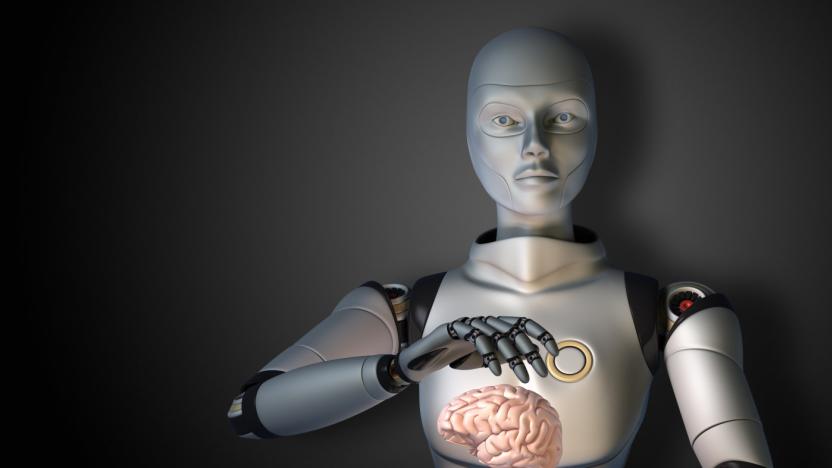culture
Latest

Marvel's STEM challenge gives one teenage girl an internship
Alongside the next installment of its Cinematic Universe, Marvel is hosting a STEM challenge for teenage girls. The studio teamed up with Dolby, Synchrony Bank, Broadcom Masters and the National Academy of Sciences for the Captain America: Civil War Girls Reforming the Future Challenge. The contest seeks submissions from girls age 15 to 18 (grades 10-12) "who are inspired to create a positive world through science and technology."

Amazon working on an education platform for course materials
Following in the footsteps of Apple and Google, Amazon's another tech company with sights set on education. As TechCrunch reports, earlier this month the e-commerce giant quietly opened the floodgates to its Amazon Education Wait List, which encourages educators to sign up for more information about an upcoming "revolutionary" platform. "The future of education is open," reads the landing page for Amazon's new venture.

We're live at SXSW Interactive 2016!
Hello Austin! Once again SXSW -- the weird and wonderful show for interactive digital technology -- is upon us, and Engadget's here in full force to bring you the best bits as they happen. Unlike other shows that offer the latest phones, TVs or games, SXSW is all about the big ideas, the slightly crazy ideas, and hottest topics in tech. Expect innovative uses for VR, off-beat music installations, buckets of BBQ, and even a visit from the President. We'll be covering it all (minus, perhaps, the BBQ), and you can follow along right here on Engadget. If you want to make sure you don't miss a thing, then you can closely follow all our coverage here, or get the highlights (and behind the scenes fun) via Instagram, Twitter or Snapchat.

Even robots can't survive Fukushima's ground zero
Five years after an earthquake-triggered tsunami hit Japan's Fukushima Daichi nuclear power plant, there's still a tremendous amount of cleanup work left. The Tokyo Electric Power Co. (TEPCO), which runs the plant, has managed to clean out spent fuel rods from one building, but it's failed to reach others that have melted down. The incredibly high radiation levels at the site have even proven too much for five robots that were sent in to find those rods, Reuters reports. Even worse, it takes around two years for TEPCO to design robots suited to individual buildings at Fukushima.

Adobe warns users to patch a critical Flash vulnerability
Stop me if you've heard this one. Adobe has released a new patch for Flash that fixes "critical vulnerabilities that could potentially allow an attacker to take control of the affected system," according to the security bulletin. It says the update (version 21.0.0.182) is a top priority for users of Windows, Mac, Android, iOS and ChromeOS, so you should install it tout de suite. The upgrade patches 23 holes in the software, but Adobe said one of them, CVE-2016-1010 "is [already] being used in limited, targeted attacks."

ICYMI: Space junk reboot, biological machine v2 and more
#fivemin-widget-blogsmith-image-763516{display:none;} .cke_show_borders #fivemin-widget-blogsmith-image-763516, #postcontentcontainer #fivemin-widget-blogsmith-image-763516{width:570px;display:block;} try{document.getElementById("fivemin-widget-blogsmith-image-763516").style.display="none";}catch(e){}Today on In Case You Missed It: NASA thinks it can extend the life of even dead satellites orbiting Earth with a new solution from the agency and Orbital ATK. Mission Extension Vehicles should go up in 2018 and give the sats battery power for as long as another 15 years. A game developer is trying to make older, classic Nintendo games 3D with an emulator that uses a custom algorithm to separate flat backgrounds into 3D objects. And the National Science Foundation funded work to create a biological machine that can be controlled with electrical or optical signals-- while using it's own muscle tissue for power. We also wanted to make sure you saw the ostrich chase video that is making the rounds. As always, please share any interesting science or tech videos, anytime! Just tweet us with the #ICYMI hashtag to @mskerryd.

Google is using neural networks to improve Translate
Google has got a pretty good handle on AI, judging by its shocking back-to-back wins against a 9-dan champ Lee Sedol in the intricate strategy game Go. Though the company is using it in Google Photos, Gmail and other apps, it may soon bring deep learning to one that really needs it: Google Translate. Anybody who uses that app regularly knows that its translations are flaky, at best, especially for languages that are vastly different from English, like Sedol's native Korean.

DOJ files a response to Apple in San Bernardino iPhone case (update)
The Department of Justice is not happy with Apple's refusal to unlock the iPhone 5c of San Bernardino shooter Syed Rizwan Farook, as stated in a response filed today. "By Apple's own reckoning, the corporation -- which grosses hundreds of billions of dollars a year -- would need to set aside as few as six of its 100,000 employees for perhaps as little as two weeks," the DOJ writes. "This burden, which is not unreasonable, is the direct result of Apple's deliberate marketing decision to engineer its products so that the government cannot search them, even with a warrant."

An interview with one of NASA's Curiosity Rover engineers
With his Elvis haircut, his fondness for cowboy boots and the way he'll launch into soliloquies about big ideas like how to bend humanity toward collective self-improvement, Adam Steltzner might come off at first as some kind of hipster philosopher. That's one of the things that makes him such a memorable ambassador for NASA, his employer. Steltzner is in fact an engineer with an improbable combination of geek cred and California cool who this October will have spent 25 years working at NASA's Jet Propulsion Laboratory. He looks like a rock star -- plays bass guitar, in fact -- and can forcefully insist on humanity's imperative to explore the stars and to press against the limits of the known universe with little prompting.

FCC Chair proposes new data privacy rules for consumers
Federal Communications Commission chairman Tom Wheeler made his case for an ambitious plan to better defend consumer data privacy on Wednesday. His proposal would effectively govern how ISPs can leverage user data for marketing and advertising purposes in the same way that that the FCC already regulates data collected by your phone company.

Wikipedia is developing a crowdsourced speech engine
Wikipedia announced on Thursday that it is collaborating with researchers from Sweden's KTH Royal Institute of Technology to develop an open, crowdsourced speech engine that will make the online encyclopedia more accessible to people with reading or visual impairments. Wikipedia estimates that 25 percent of its user base -- approximately 125 million people monthly -- will benefit from the new service. And while the engine will be optimized for use on Wikipedia itself, any site running MediaWiki software will be able to integrate it as well.

Under Armour will sell partially 3D-printed shoes for $300
When Adidas showed off its Futurecraft 3D concept late last year, it wasn't really clear how close to reality 3D-printed shoes were. Well, they're much closer today. Under Armour is debuting its UA Architechs, a new training shoe that has a 3D-printed midsole. Okay, so this isn't quite reaching Adidas' dream of personalising shoes based on individuals' needs, but 3D-printing does have its uses. The midsole here provides what Under Armour refers to as a "dynamic stability platform." It's an interlacing lattice structure that's supposed to bring all the benefits of "energy returning" foams, while offering improved stability. The idea is to create a shoe that's just as suitable for cross training as it is for weight lifting. Whether 3D-printing is actually required to create this lattice, or if regular manufacturing techniques could handle it just fine, isn't clear. But it's nonetheless an important step along the journey to creating a 3D-printed shoe for the masses. The UA Architechs are being produced on a super-limited run -- only 96 will be made -- and will be sold at $300.

New electric GT racing series to feature Tesla's Model S
As soon as next year, Formula E will have some company. The Electric GT World Series was announced this week, aiming to field 10 teams for its first season in 2017. What's more, the new series will be the first all-electric GT racing series. The plan is for those 10 teams to put 20 cars on the track at seven different races during the first year. In true GT (Gran Tourer) form, the series will use production cars that are available for consumer road use. Series officials say there's only one current vehicle that fits the bill: the Tesla Model S.

Hackers tried and failed to steal a billion dollars from bank
Hackers stole $80 million from a bank, but it could have been a lot worse if they had just Googled the name of a company, according to Reuters. Thieves got inside servers of the Bangladesh Bank, stealing the credentials used to make online transfers. They then bombarded the Federal Reserve Bank in New York with up to 13 money transfer requests to organizations in the Philippines and Sri Lanka. The Fed allowed four to go through totaling $81 million, but the next one was flagged by a routing bank in Germany because the hackers misspelled "foundation" as "fandation."

ICYMI: Music with your eyes, 3D print everything and more
#fivemin-widget-blogsmith-image-512707{display:none;} .cke_show_borders #fivemin-widget-blogsmith-image-512707, #postcontentcontainer #fivemin-widget-blogsmith-image-512707{width:570px;display:block;} try{document.getElementById("fivemin-widget-blogsmith-image-512707").style.display="none";}catch(e){}Today on In Case You Missed It: An engineer built a DIY musical instrument for people with disabilities, helping them create music with an eyetracking device. Two 3D-printed bits of technology caught our attention: One is for flesh, the other graphene aerogel. We are also reviewing a messenger app and a Kickstarter campaign for a speaker that basically makes us crazy. As always, please share any interesting science or tech videos, anytime! Just tweet us with the #ICYMI hashtag to @mskerryd.

Hyperloop deal would link three European capitals
One of the companies vying to make Elon Musk's transportation dream a reality has signed a deal with the government of Slovakia to explore building a three-country Hyperloop. Crowdsourced engineering project Hyperloop Transportation Technologies (HTT) will look into a route that links three European capitals. From Vienna, Austria to Bratislava, Slovakia, and from Bratislava to Budapest, Hungary.

Apple's Eddy Cue on FBI iPhone feud: 'Where does it stop?'
Apple continues to make its case in the court of public opinion about its ongoing dispute with the FBI. In a Spanish interview with Univision, Senior VP Eddy Cue says that if the agency forces Apple to create software to unlock San Bernardino shooter Syed Rizwan Farook's iPhone, it would only benefit the bad guys. "If we make a key that opens all phones ... terrorists, criminals and pirates would find it," he says. Furthermore, Cue thinks that if its petition is successful, the FBI might make more sinister requests of Apple. "For example, one day they may want us to open your phone's camera and microphone."

Google+ Create program will highlight experts in their field
Google+ has launched a new program called "Create" that puts makers, artists, influencers and experts in their field in front of a bigger audience. If you'll recall, Mountain View redesigned its social network last year to focus on Communities and Collections. Communities are a place where people can share posts revolving around their interests, while Collections is a feature that collates a user's posts that focus on a single topic.

Pentagon has deployed military drones in the US
If you were skeptical that the US military would only fly its drones in combat zones, your suspicions were well-founded -- although the situation isn't as bad as you might think. A recently published Department of Defense report has revealed that the Pentagon deployed spy drones in the US for non-military missions between 2006 and 2015. There were "less than twenty" of these flights, and the Department maintains that all of them obeyed laws restricting the use of these drones at home. While the document doesn't say what happened on those flights, the current policy forbids spying on US residents.

Watch leading thinkers debate the risks and rewards of AI
The advent of artificial intelligence is as dreaded as it is lauded. Proponents believe it's a technological advancement that will augment humans in unprecedented ways -- think immortality and super-intelligence. But the critics often point out the dangerous repercussions of this revolution -- autonomous weapon systems and self aware bots. Should we brace ourselves for a robotic apocalypse? Is that idea based on science fiction or reality? Does the fear of AI slow down the progress of a technology that could amplify human existence? Tune in for a riveting debate -- "Don't trust the promise of artificial intelligence."











